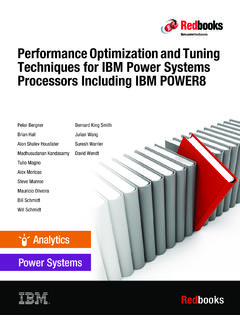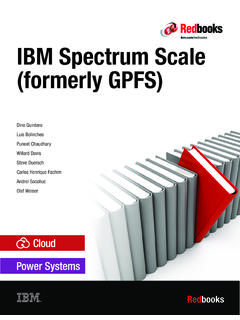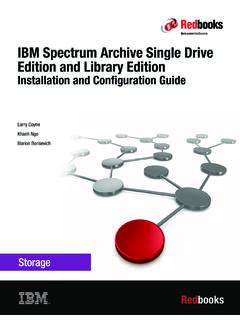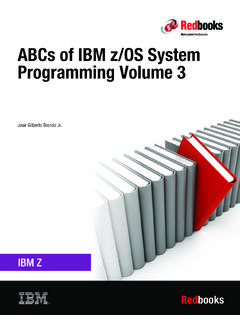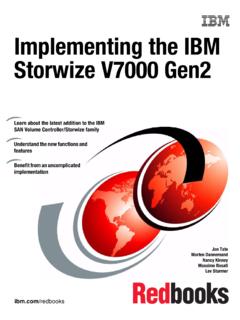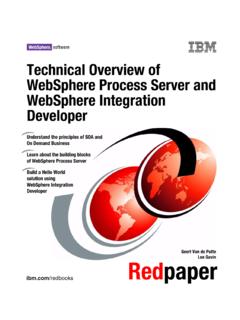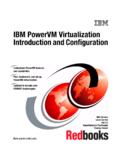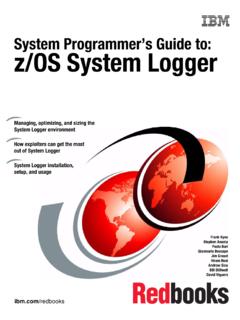Transcription of The Era of Cognitive Systems: An Inside Look at IBM Watson ...
1 Front coverThe Era of Cognitive Systems: An Inside look at IBM Watson and How it Works Rob HighLearn how Cognitive systems, such as IBM Watson , can transform how organizations think, act, and operateUnderstand the natural language processing capabilities and more of IBM WatsonSee how evidence-based responses can drive better outcomesRedguidesfor Business Leaders Copyright IBM Corp. 2012. All rights overviewIBM Watson represents a first step into Cognitive systems, a new era of computing. Watson builds on the current era of programmatic computing but differs in significant ways. The combination of the following capabilities makes Watson unique: Natural language processing by helping to understand the complexities of unstructured data, which makes up as much as 80 percent of the data in the world today Hypothesis generation and evaluation by applying advanced analytics to weigh and evaluate a panel of responses based on only relevant evidence Dynamic learning by helping to improve learning based on outcomes to get smarter with each iteration and interactionAlthough none of these capabilities alone are unique to Watson , the combination delivers a powerful solution.
2 To move beyond the constraints of programmatic computing To move from reliance on structured, local data to unlock the world of global, unstructured data To move from decision tree-driven, deterministic applications to probabilistic systems that co-evolve with their users To move from keyword-based search that provides a list of locations where an answer might (or might not) be located, to an intuitive, conversational means of discovering a set of confidence-ranked responsesCognitive systems, such as IBM Watson , can transform how organizations think, act, and operate in the future. This IBM Redguide publication describes how Watson combines natural language processing, dynamic learning, and hypothesis generation and evaluation to give direct, confidence-based responses. 2 The Era of Cognitive Systems: An Inside look at IBM Watson and How it WorksWhat language is and why it is hard for computers to understandLanguage is the expression of ideas.
3 It is the medium by which we communicate an understanding of things between people. It is how we convey fear, hope, history, and directions for the future. Some say that it is what we use to think, speculate, and imagine. It is at the base of our cognition, our ability to understand the world around us, or at least at the base of our ability to manipulate and exchange that it is incredibly language is full of innuendos, idiosyncrasies, idioms, and ambiguity. We have noses that run, and feet that smell. How can a slim chance and a fat chance be the same, but a wise man and a wise guy are opposites? How can a house burn up as it burns down? Why do we fill in a form by filling it out?And yet, it can be amazingly convey so much meaning, and accomplish so much collaboration even in the midst of all the difficulties with language. Somehow, we can see through the gaps, the inconsistencies and contradictions, the irregularity, and the lack of clarity and still understand each other with a great deal of difference between precision and accuracy is important.
4 Precision is the mechanical or scientific exactness that can be found in a passage of text. We can determine whether a specific word exists within a passage with a high degree of precision. Accuracy is the degree to which one passage infers that another passage might be considered to be true by reasonable answer to 2 + 2 is precisely 4. Mathematics teaches us this fact. It also teaches us that, regardless of how many zeros you place after the decimal to represent greater precision, the answer always derives to 4. But what if, when we say 2 + 2, we did not mean it to be taken literally as a mathematical formula, but rather as an idiom for a car configuration, as in two front seats and two back seats. Or what if a psychologist is using 2 + 2 to refer to a family with two parents and two children? In those other contexts, the answer four might not be an accurate interpretation of what we are trying to convey in the fact, to accurately answer a question, you must often consider the available context for the question.
5 Without enough evidential information, it is difficult to accurately respond to a question, even though you can precisely answer elements in the question natural language processingMany natural language systems have attempted to emphasize precision within the confines of specific well-formed rules. For example, sentiment analysis often looks for a set of specific words and their synonyms within a social media site. These systems then, without further assessment of the context in which those words are being used, tally the number of times those words are co-located with some brand in the same phrase. For example, it takes the phrase, .. stopped by the IBM Donut Store for a coffee this morning, it was great .. and then asserts that the collocation of the brand name and the term great are an indication of a positive sentiment. However, consider if the rest of the phrase is, .., it was great to hear that What if, when we said 2 + 2, we meant a car configuration, as in two front seats and two back seats?
6 3a new Fictional Coffee Shop is opening soon, so I am not tempted to eat donuts every morning. Then, the system might miss that the sentiment is not about the IBM Donut Store. We call this concept shallow natural language processing (NLP) because, although it might be fairly precise within its more narrow focus, it is not very , it is also important to realize that shallow NLP actually has an important role in many systems. If your intent is to create a statistically relevant assessment of sentiment trends over huge quantities of information, the lack of accuracy for each individual example is likely not an issue. Assuming that there are approximately as many false-positives as there are false-negatives over a sufficiently large sample set, they cancel each other out. And if the pool of canceled tallies remains relatively constant across sample sets over time, the remaining uncanceled data yields statistically relevant trending information.
7 Thus, the additional processing costs that are required for the additional accuracy for any instance might be , when the individual instances matter, the systems that are designed to be precise without focusing on high levels of accuracy tend to be brittle. That is, they perform well within the narrow parameters of their intended design, but they do not perform well when those parameters change. We liken these systems to using brick-laying construction techniques. Bricks are strong and fairly easy to construct with. For decades and centuries, we refined the brick-laying construction technique to be fairly precise. We were able to build relatively large, ornate, and long-lasting structures. However, although brick buildings have great load strength, they have poor tensile strength. They fall down easily in earthquakes and do not support large spans. And after a certain point, their load strength will fail can observe these same limitations in some consumer products today.
8 For example, you might use your favorite voice-activated personal assistant and say, Find me pizza. In return, you get a local listing of pizza restaurants, which is exactly what you wanted. Now you say, Do not find me pizza. You still get back a local listing of pizza restaurants, which is not exactly what you asked for. Likewise, if you say Find me pizza nearby or Find me pizza far away , the same local listings are returned. The point is that these systems are designed according to a specific set of rules and are looking for specific keyword combinations to determine the answer to produce. These systems do not know how to distinguish between things for which there is no rule. They might be precise, but not necessarily very natural language processingTo overcome the limitations of brick building, we shifted to using steel and reinforced concrete for larger buildings. Likewise, we are seeing a shift in construction techniques for natural language processing when accuracy is needed over narrow precision.
9 These techniques incorporate much more context into the evaluation of the question. We refer to this concept as deep natural language processing, which is sometimes called Deep Question-Answering (DeepQA) when the problem is about answering natural language Watson is a deep NLP system . It achieves accuracy by attempting to assess as much context as possible. It gets that context both within the passage of the question and from the knowledge base (called a corpus) that is available to it for finding natural language processing can be fairly precise within its more narrow focus, but is not very are seeing a shift in construction techniques for natural language processing when accuracy is The Era of Cognitive Systems: An Inside look at IBM Watson and How it WorksWhen preparing for the quiz show, JEOPARDY!, Watson was asked the following question (clue) from the category Lincoln Blogs: Treasury Secy. Chase just submitted this to me for the third time - guess what pal, this time I'm accepting it.
10 First, notice the abbreviation, Secy. , which had to be taken to mean Secretary. Further notice that Secretary is not meant here to be someone who takes dictation and manages an appointment book. The combined terms Treasury Secretary is significant here as a noun and a role. Therefore, to answer this question, Watson had to find a passage that involved submitting and accepting something between Treasury Secretary Chase and Lincoln (the category of the clue). However, also notice that the category does not say President Lincoln necessarily. The correct answer turned out to be What is a resignation? .When describing this example at an elementary school sometime after the broadcast of IBM Watson playing JEOPARDY!, one fifth grade student offered What is a friend request? as a possible answer from this student is interesting in part because it says a lot about the degree to which social media has permeated deeply into the fabric of the next generation of society.
